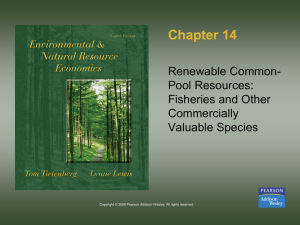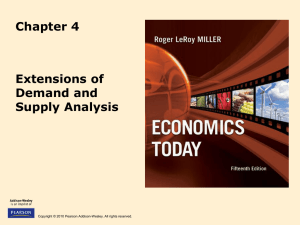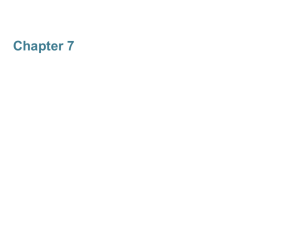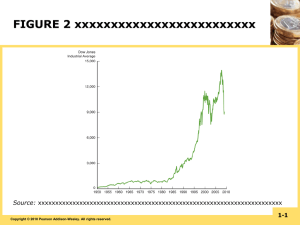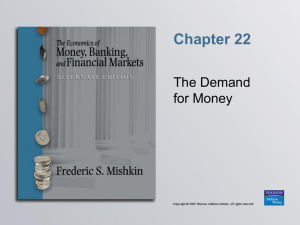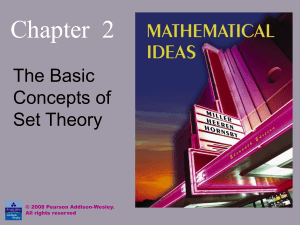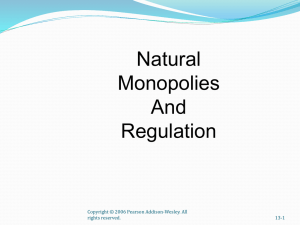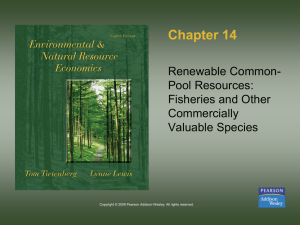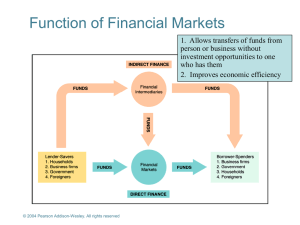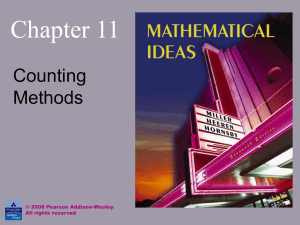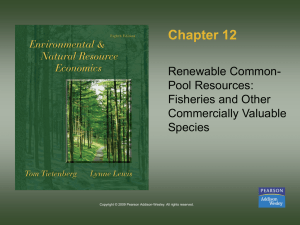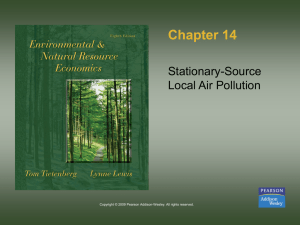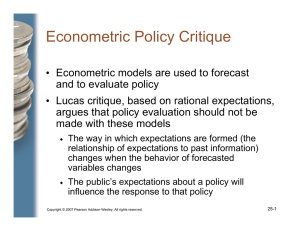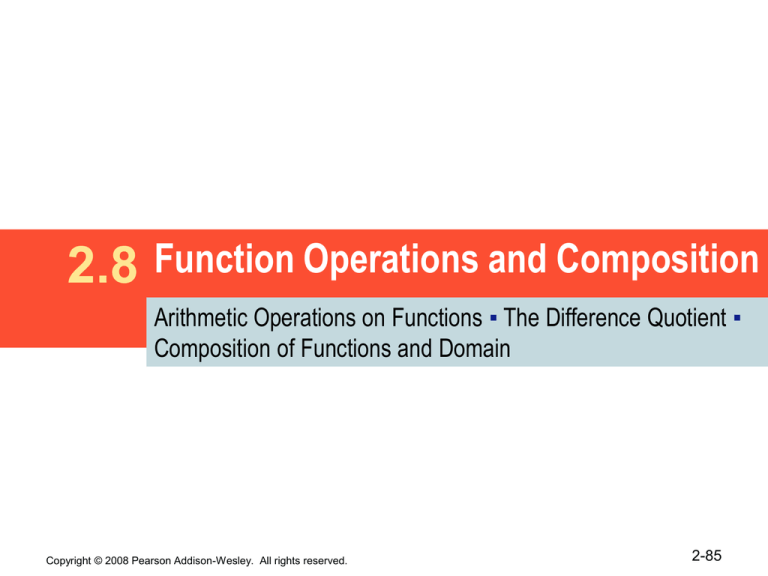
2.8
Function Operations and Composition
Arithmetic Operations on Functions ▪ The Difference Quotient ▪
Composition of Functions and Domain
Copyright © 2008 Pearson Addison-Wesley. All rights reserved.
2-85
2.8
Example 1 Using Operations on Functions (page 275)
Let f(x) = 3x – 4 and g(x) = 2x2 – 1. Find:
(a) (f + g)(0)
= f(0) + g(0)
= -4 + -1
= -5
(c) (fg)(–2)
(b) (f – g)(4)
= f(4) – g(4)
= 8 – 31
= -23
(d)
Copyright © 2008 Pearson Addison-Wesley. All rights reserved.
= f(-2) • g(-2)
= -10 • 7
= -70
= f(3)/g(3)
= 5/17
2-86
2.8
Example 2(a) Using Operations on Functions (page 276)
Let f(x) = x2 – 3x and g(x) = 4x + 5. Find each
function and give the domain.
(f + g)(x) =
= f(x) + g(x)
= (x2 – 3x) + (4x + 5)
= x2 + x + 5
Domain is (-∞,∞)
(f – g)(x)
= f(x) – g(x)
= (x2 – 3x) – (4x + 5)
= x2 – 7x – 5
Domain f – g (-∞,∞)
(fg)(x)
= f(x)•g(x)
= (x2 – 3x)(4x + 5)
= 4x3 + 5x2 – 12x2 – 15x
= 4x3– 7x2 – 15x
Domain is (-∞,∞)
Domain is (-∞,-5/4)U(-5/4,∞)
2-87
2.8
Example 3(a) Evaluating Combinations of Functions
Use the graph below to evaluate
(page 277)
(f + g)(1), (f – g)(0),
(fg)(–1), and
(f + g)(1) = f(1) + g(1)
=3+1=4
(f – g)(0) = f(0) – g(0)
=4–0=4
(fg)(–1) = f(-1)•g(-1)
= (3)(1) = 3
(f/g)(–2) = f(-2)/g(-2)
= 0/2 = 0
Copyright © 2008 Pearson Addison-Wesley. All rights reserved.
2-88
2.8
Example 3(b) Evaluating Combinations of Functions
(page 277)
Use the representations of the functions f and g to
evaluate (f + g)(1), (f – g)(0),
(fg)(–1), and
(f + g)(1) = f(1) + g(1)
=1+6=7
(f – g)(0) = f(0) – g(0)
= –1 – 4 = –5
(fg)(–1) = f(-1)•g(-1)
= (–3)(2) = –6
, is undefined
Copyright © 2008 Pearson Addison-Wesley. All rights reserved.
2-89
2.8
Example 3(c) Evaluating Combinations of Functions
(page 277)
Use the representations of the functions f and g to
evaluate (f + g)(1), (f – g)(0), (fg)(–1), and
(f + g)(1) = f(1) + g(1) = 7 – 1 = 6
(f – g)(0) = f(0) – g(0) = 4 – 0 = 4
(fg)(-1) = f(-1)•g(-1) = (1)(–1) = –1
Copyright © 2008 Pearson Addison-Wesley. All rights reserved.
2-90
2.8
Example 4 Find the Difference Quotient (page 278)
Let f(x) = 3x2 – 2x + 4. Find the difference quotient and
simplify the expression.
Difference Quotient
3(junk)2 – 2(junk) + 4 – f(x)
h
2.8
Example 5(a) Evaluating Composite Functions (page 279)
Let
Find
and
.
First find g(2) and then
plug that answer into f(x):
Copyright © 2008 Pearson Addison-Wesley. All rights reserved.
.
Find
.
First find f(5) and then plug that
answer into g(x):
2-92
2.8
Example 6(a) Determining Composite Functions and
Their Domains (page 280)
Let
and
and determine its domain.
. Find
Domain of
Find
Domain:
2x + 4 > 0
and determine its domain.
Domain:
x–1>0
Domain of
Copyright © 2008 Pearson Addison-Wesley. All rights reserved.
2-93
2.8
Example 7(a) Determining Composite Functions and
Their Domains (page 280)
Let
and
. Find
and determine its domain.
Domain of
Find
and determine its domain.
The domain of
2-94
2.8
Example 8 Showing that (g ◦ f )(x) ≠ (f ◦ g)(x) (page 281)
Let f(x) = 2x – 5 and g(x) = 3x2 + x.
Show that (g ◦ f )(x) ≠ (f ◦ g)(x).
So, (g ◦ f )(x) ≠ (f ◦ g)(x)
Copyright © 2008 Pearson Addison-Wesley. All rights reserved.
2-95
2.8
Example 9 Finding Functions That Form a Given
Composite (page 282)
Find functions f and g such that
(f ◦ g )(x) = 4(3x + 2)2 – 5(3x + 2) – 8.
Note the repeated quantity 3x + 2.
Choose g(x) = 3x + 2 and f(x) = 4x2 – 5x – 8.
Then (f ◦ g )(x) = 4(3x + 2)2 – 5(3x + 2) – 8.
There are other pairs of functions f and g that also
work. For instance, let f(x) = 4(x + 2)2 – 5(x + 2) – 8
and g(x) = 3x.
Copyright © 2008 Pearson Addison-Wesley. All rights reserved.
2-96
2.8 Summary
Function Operations and Composition
Arithmetic Operations on Functions
The Difference Quotient
Composition of Functions and Domain
Copyright © 2008 Pearson Addison-Wesley. All rights reserved.
2-97







